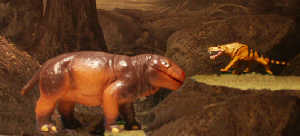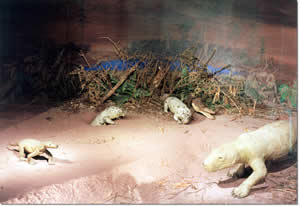The Late Permian
In the terminal Late Permian, Lopingian, Tatarian, or Zechstein epochs, the climate conditions continue to get worse that by the end life may only have been possible at low attitudes. The extinction at the end of the Kazanian replaced the Dinocephalian fauna in South Africa by new groups of big herbivores - the beaked and toothless dicynodonts. These were clearly descended from animals which were common but restricted to small body sizes earlier. The smaller pig and sheep sized dicynodonts a the most common herbivores in this period and into the following Triassic. At the end of the Permian is the greatest extinction of all time, 95% of land and sea species die out. There may have been an impact towards the end of the period. The balance of evidence points to an environmental disaster tied to increased carbon caused by the eruption of volcanoes in Siberia. Intense heat, the spread of deserts with irregular climate and low oxygen rates make for a nasty time. The final act was the rise in temperature of the oceans that killed off most of the sea life.
The Tropidostoma fauna
 One family dominates the top predator role, the
gorgonopsians. Gorogonopsids were lightly built meat eaters with long
running legs, and were a dominant predators that may have hunted in packs. Lycaenops ('Wolf face) a gorogonopsid had two prominent canine teeth. It seems like Lycaenops and its relatives
were reptilian saber-toothed tigers of the Late Permian.
One family dominates the top predator role, the
gorgonopsians. Gorogonopsids were lightly built meat eaters with long
running legs, and were a dominant predators that may have hunted in packs. Lycaenops ('Wolf face) a gorogonopsid had two prominent canine teeth. It seems like Lycaenops and its relatives
were reptilian saber-toothed tigers of the Late Permian.
 Initial diversity of large dicynodonts may have been low, with one genus, Endothiodon, dominating some early local faunas. But within a relatively short
period more big dicynodont families and four fully terrestrial big
families become common, plus pareiasaurs, the big herbivores that were
the only survivors over 15 kg from the Dinocephalian fauna. Most
dicynodonts were characterized by a pair of tusks, Endothiodon was a large
example of the tusk less variety. The tusked dicynodonts survived into the
following Triassic period.
Initial diversity of large dicynodonts may have been low, with one genus, Endothiodon, dominating some early local faunas. But within a relatively short
period more big dicynodont families and four fully terrestrial big
families become common, plus pareiasaurs, the big herbivores that were
the only survivors over 15 kg from the Dinocephalian fauna. Most
dicynodonts were characterized by a pair of tusks, Endothiodon was a large
example of the tusk less variety. The tusked dicynodonts survived into the
following Triassic period.
The final wave of extinction at the end of the Permian fnished off the last of the Pareiasaurs. Scutosaurus would needed to stay close the the last remaining vegatation in arid environment. The 8 foot long armored animal may have been the last large herbivore.
 Procynosuchus and Dicynodon are unique Central Europe fauna. Procynosuchus may have lived a semi-aquatic lifestyle like modern otters, most cynodonts were terrestrial. It was around 60 cm in length, and probably fed on a diet of fish. Dicynodon ("Two Dog-teeth") cropped vegetation with a horny beak, like a tortoise and had tusks used for digging up roots and tubers. Less than 4 feet long on average it may have burrowed to mitigate the effects of the deteriorating climate. The survivors faced a long period of low oxygen content.
Procynosuchus and Dicynodon are unique Central Europe fauna. Procynosuchus may have lived a semi-aquatic lifestyle like modern otters, most cynodonts were terrestrial. It was around 60 cm in length, and probably fed on a diet of fish. Dicynodon ("Two Dog-teeth") cropped vegetation with a horny beak, like a tortoise and had tusks used for digging up roots and tubers. Less than 4 feet long on average it may have burrowed to mitigate the effects of the deteriorating climate. The survivors faced a long period of low oxygen content.
